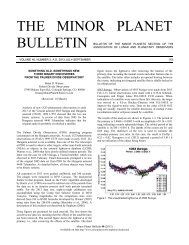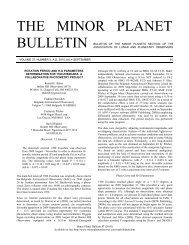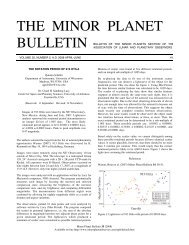THE MINOR PLANET BULLETIN - MinorPlanet.Info
THE MINOR PLANET BULLETIN - MinorPlanet.Info
THE MINOR PLANET BULLETIN - MinorPlanet.Info
- No tags were found...
Create successful ePaper yourself
Turn your PDF publications into a flip-book with our unique Google optimized e-Paper software.
97<br />
were chosen by comparing well-placed asteroids to the list of<br />
known lightcurve parameters maintained by Harris and Warner<br />
(2008). We focused our observations on two large and bright<br />
asteroids for which a high uncertainty in the actual rotational<br />
period existed.<br />
566 Steroskopia. Previously published periods for this asteroid,<br />
based on sparsely populated lightcurves, ranged from 9.685 h by<br />
Blanco et al. (2000) to 17.76 h by Behrend (2008). Our densely<br />
populated lightcurve, derived over 10 nights and spanning just<br />
longer than a month, fits neither of those previous periods.<br />
Instead, we find a stable solution for a period of 12.103 ± 0.002 h.<br />
823 Sisigambis. Previously published periods for this asteroid,<br />
based on sparsely populated lightcurves, ranged from greater than<br />
24 h by Barucci et al. (1994) as well as Wisniewski et al. (1997) to<br />
146.2 h by Behrend (2008). Despite observing the asteroid<br />
exclusively for six nights over a two-week period, we were unable<br />
to find a high-quality solution. This is mainly due to the very low<br />
amplitude variations observed over an entire night, which<br />
typically spanned 5-6 h of observational time. A similar trend was<br />
observed by Wisniewski et al. (1997). They show a single night<br />
lightcurve for 823 Sisigambis that covers approximately 3 h and is<br />
basically flat. Barucci et al. (1994) reported a drop of ~0.2 mag<br />
over a 5 h period. When Wisniewski et al. (1997) observed the<br />
asteroid during the same night, with a 30-minute overlap, they<br />
found the lightcurve to be flat. We were unable to observe a<br />
maximum during the 6 nights of observations, which would have<br />
helped in predicting the period. Bowing to Occam’s Razor, we<br />
present here a possible solution with a period of 21.0 h. We also<br />
show a lightcurve with a period of 146.2 h as predicted by<br />
Behrend (2008). It should be pointed out that since we used<br />
differential photometry, the absolute location of the individual<br />
nights on this plot is arbitrary and could be shifted up or down.<br />
Further data for this large and bright asteroid are clearly needed.<br />
References<br />
Barucci, M.A., Di Martino, M., Dotto, E., Fulchignoni, M.,<br />
Rotundi, A., and Burchi, R. (1994) “Rotational Properties of Small<br />
Asteroids: Photoelectric observations of 16 asteroids.” Icarus 109,<br />
267-273.<br />
Behrend, R. (2008). Observatoire de Genève web site.<br />
http://obswww.unige.ch/~behrend/page_cou.html<br />
Blanco, C., Di Martino, M., and Riccioli, D. (2000). “New<br />
rotational periods of 18 asteroids.” Planet. Space Sci. 48, 271-284.<br />
Fauerbach, M. and Bennett, T. (2005). “First photometric<br />
lightcurve observations from the Evelyn L. Egan Observatory.”<br />
Minor Planet Bull. 32, 34-35.<br />
Harris, A.W., and Warner B.D. (2008). http://www.minorplanet<br />
observer.com/astlc/LightcurveParameters.htm<br />
Wisniewski, W.Z., Michalowski, T.M., Harris, A.W., and<br />
McMillan, R.S. (1997). “Photometric Observations of 125<br />
Asteroids.” Icarus 126, 395-449.<br />
# Name Date Range<br />
(yyyy mm/dd)<br />
Data<br />
Pts<br />
Minor Planet Bulletin 36 (2009)<br />
Phase LPAB BPAB Per<br />
(h)<br />
566 Stereoskopia 2008 01/03-02/05 554 12.4,17.6 65 -0.5 12.103 0.002<br />
823 Sisigambis 2007 12/12-12/26 292 13.2,19.5 58 0.7 21.0 0.1<br />
PE










